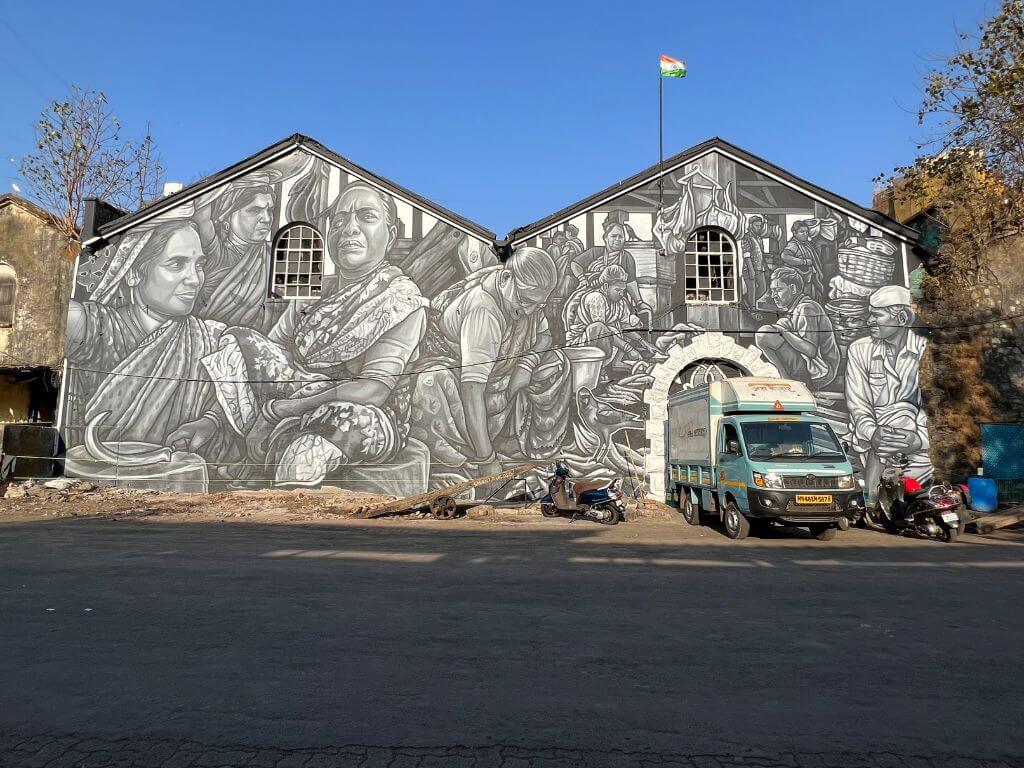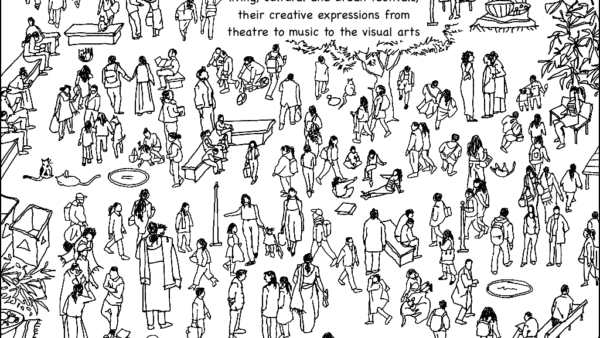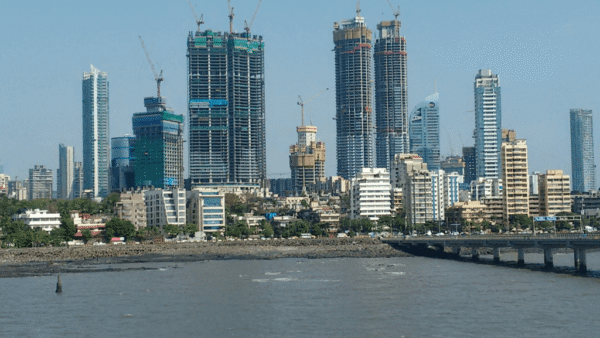It took more than a year for the Govandi Arts Festival to take shape. From skepticism, the residents of Natwar Parekh Compound gradually moved to a comfortable relationship with the Community Design Agency. Through workshops, interventions and conversations, they realised their talents for art, music, and filmmaking. The process of organising and participating in the festival brought the resettlement and rehabilitation colony residents together. Down in south Mumbai, the Sassoon Docks Art Project was subsumed into the larger format Mumbai Urban Arts Festival but ensured that the fisherfolk at the docks and surrounding areas, Mumbai’s Koli community, were represented in the exhibits and as participants despite their initial apprehensions to showcase art that tells the story of their city and their sea.
There are still boundaries to be crossed and peaks to be climbed, say the organisers of the two festivals in this dialogue-interview with Question of Cities. “People not only have an alternative space but also reimagine an alternative way of living and interacting,” says Natasha Sharma, one of the two curators of Govandi Arts Festival. Priyansha Jain, one of the curators of Mumbai Art Festival, says it is quite rare for a working dock to give public access but the Sassoon Docks has it, so people came and it helped create a particular dialogue about Kolis, sea and so on.
Tell us how your festivals came to be.
Natasha Sharma: We, in the Community Design Agency, were ambitious but knowing the Govandi neighbourhood, we want to do a public art festival that would match the scale. We had our first workshop in April 2022 with interested people, especially the youth, and began by asking them what Govandi meant to them, what art means to them, what they understood by a festival. We wanted to see if they connected the three. Art, they said, meant sukoon, creative resistance, expression, also shanti. These flowed naturally. This process helped us create this neighbourhood-led festival not rooted in religion but in people, their identities and stories. People came not only from Natwar Parekh Compound but also from the surrounding Slum Rehabilitation buildings. After that, we began facilitating mentorship programs and residencies with the youth.It is like creating the right conditions for a seed to sprout, then it not only grows and survives, but flourishes.
Priyansha Jain: We, in St+art India were thinking about how the city is always changing, expanding, altering in many ways. We were inspired by two books – Rahul Mehrotra’s Kinetic Cities, and Dilip Dcunha and Anuradha Mathur’s Soak which looks at Mumbai as an estuary. We gathered how a city that’s constantly changing and evolving, and what happens within the water body. The water body is never still, it never has a hard boundary. It is a porous medium, liquid, just like the city has been which has allowed for so much migration. And, it became clear that the city has a very strong relationship with water.

Photo: Tejinder Singh Khamkha
How did you both zero in on the venues for the two festivals?
Natasha Sharma: The founder of CDA, Sandhya Naidu Janardhan met Parveen Shaikh, a resident of Natwar Parekh Compound in Govandi and a community organiser within our organisation. They began by talking over many cups of chai and, over months, built a relationship of trust. When you sit with the community, you realise the complexity of the problems that they face as residents. When I came in, I started working on participatory art interventions on issues like waste management, lack of open spaces, and street design with residents of each of the buildings in the colony.
This is a Mumbai Metropolitan Region Development Authority (MMRDA) rehabilitated place which was a congested and cramped set of buildings. More than 25,000 people live on a five-hectare land here, more than Dhaka’s density. This impacts people more deeply than you can imagine. The sunlight does not reach houses and there are ventilation issues, and along with this, the way they were rehabilitated affected their social fabric. They were not feeling like a community. What the art project did was it brought people together in a way that they had forgotten. They were looking at their space as an opportunity rather than a problem, and asking what they could do together.
Priyansha Jain: The Sassoon Docks Art Project took place for the first time in 2017. That was its first edition. The Mumbai Urban Art Festival, which was the first edition this year included the Sassoon Docks Art Project. So, in some ways, it was the second edition of the Sassoon Docks Art Project but the first edition of Mumbai Urban Art Festival. The four co-founders of St+art India Foundation were trying to always create experiential exhibitions under this idea of art for all.
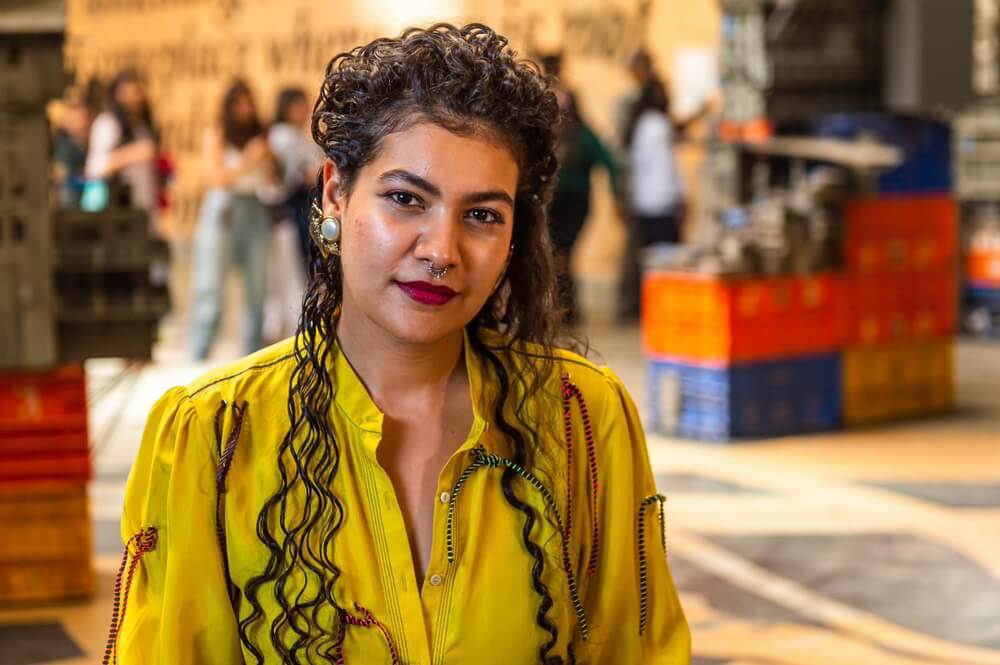
Photo: Christoph Mohr
What activities initiated this cooperation and a sense of trust among the residents or participants as each of you started working on the festivals?
Natasha Sharma: We have been working in Govandi for the past six years, and I have specifically worked on art and design interventions for the past four and a half years. When we did a waste management intervention, we installed a common dustbin for each floor for six residents to share as an alternative to them hauling the garbage in their common alleyways. It surfaced in a lot of other problems rooted in social and behavioural issues. One man said, “Yaha pe jo pork khaate hai, main unke saath share nahi karunga.” Every issue is a symptom of a larger social phenomenon, how do we address that first, was the question for us. So, we said, it is not about the garbage but about you people coming together and feeling a sense of belonging and ownership towards their space.
After a few months, one of the lanes had little to no garbage. A wedding was held in that alley in 2019. Next day, we brought plants and painted the walls to create the community’s first ever mini-garden in that space. All the kids came to play in the space which annoyed the elders because of the noise. Then, during COVID-19, everybody was at home. And the space was no longer used. But, in the community, we had tried and failed together, so cooperation and trust were intentionally built.
Priyansha Jain: We had started to do site visits in May 2022. When I went with some of the team members, it was clear that the people of Sassoon Docks already knew many from our team. We had a community leader Navnath Bochare, who is not a Koli, but has worked at the dock for two generations. He is also part of the Association of Handcart Operators. Having a community leader was very important because there are political and social differences which have to be sensitively navigated.
We hosted the festival in two buildings – Intuitions and Illusions. A stage was set up, music systems were up. We realised a month into our programming that we cannot have it in the Intuitions building, it had to be outdoors. At an event we held, rappers and karaoke guys from the community, and small children attended. They were from the docks and surrounding areas. We held a community programme at Machhimar Nagar and many wanted to perform. We spoke to the women about attending the festival because they were apprehensive. “We stink. Are we really welcome,” they asked. I urged them that we are all at the docks and we all stink, so they should be at the exhibition.
How has the reclamation of public space through art manifested in the lives of the community?
Natasha Sharma: The festival saw many visitors from Govandi and outside. The ground where we held the festival was used as a parking area for 15 years. After the festival, it has not yet been used for parking. This is a form of reclaiming space through the arts. Now, metal bars will be put on one side so that cars cannot come in. Holding space is not just a physical idea but also an emotional one. The fact that our mentees were able to perform, showcase their work, tell their stories and hold space within their colony for their voices was a huge thing.
Priyansha Jain: There are various ways to look at it. One is a particular interaction that it brings. It is quite rare for a working dock to give public access but the Sassoon Docks has it, so people come. When lakhs came, it helped create a particular dialogue about Kolis, sea and so on. There is a lot of work to do in deepening the dialogue because there are still sentences like “people from the dock” and “people from the city” which show division. Ideally, the festival will have to return for a few years to break that particular border. When the community sees artists working, they build relationships with them. For example, in Paola Defín’s mural where she painted some of the women from the dock, they saw themselves portrayed in a way that instilled pride in them because their faces were in an open-air gallery up there.
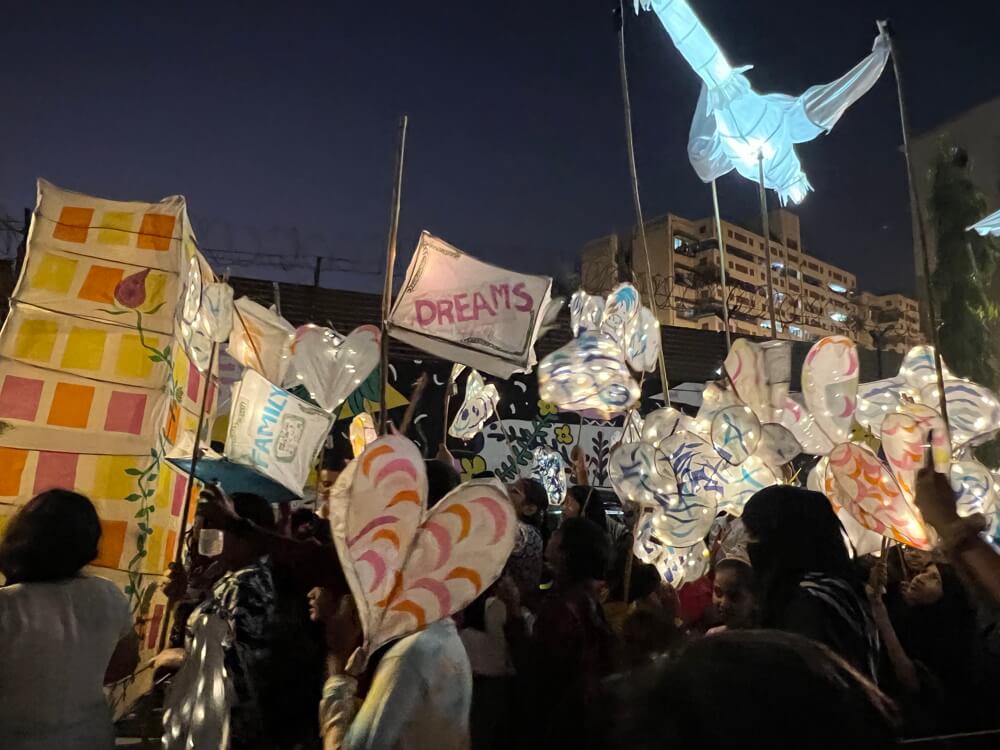
Photo: Maitreyee Rele
Natasha, in Natwar Parekh Compound, how did this initiative help to hear voices of marginalised people?
Natasha Sharma: It is based on how you want to programme it. One way is to give them prompts like “Would you like to speak about your home? What is your identity, where do you belong?” Everyone has an emotional understanding of these things but does not have the space to express it. Bhawna Jaimini (co-curator of the festival) and I created and curated a festival with an alternative pedagogy rooted in creative expression. This pedagogy is not institutionalised or politicised, but comes from the heart of the neighbourhood in a learning environment in which they feel that someone is listening, that they and their stories matter. Then, we see magic.
We need to create more open spaces but it is not just about open spaces. We put some chairs, people will sit down, what comes next is important too. How do we programme that space? How do we make interactions happen, facilitate conversations? These become the softer ways of approaching this rigid urban development model that we have.
How do festivals make art more accessible to everybody and make complex issues like ecology interesting?
Natasha Sharma: Art has a way of bringing people together. It is only when people come together can they start accepting their challenges and celebrate, which is a big part of resilience. Resilience is a part of urban development. Art is the link between resilience and bringing people together, and that is why it becomes a key component of placemaking. People not only have an alternative space but also reimagine an alternative way of living and interacting. These are the linkages I see very closely connected to the art.
This can obviously be done architecturally where we stack up benches in a nook, and we create the space. What art does is that it programmes the space, adding the emotional element to the space. Everybody is yearning for it. You don’t need to be a painter, or a rapper. We were able to sit together and jam was like playing Antakshari of our personal stories. People come together and get some joy.
Ecological vulnerabilities should be seen as social challenges as much as environmental ones. They stem directly from political, cultural and economic decisions about where and how human settlements are built, and how resources are distributed.
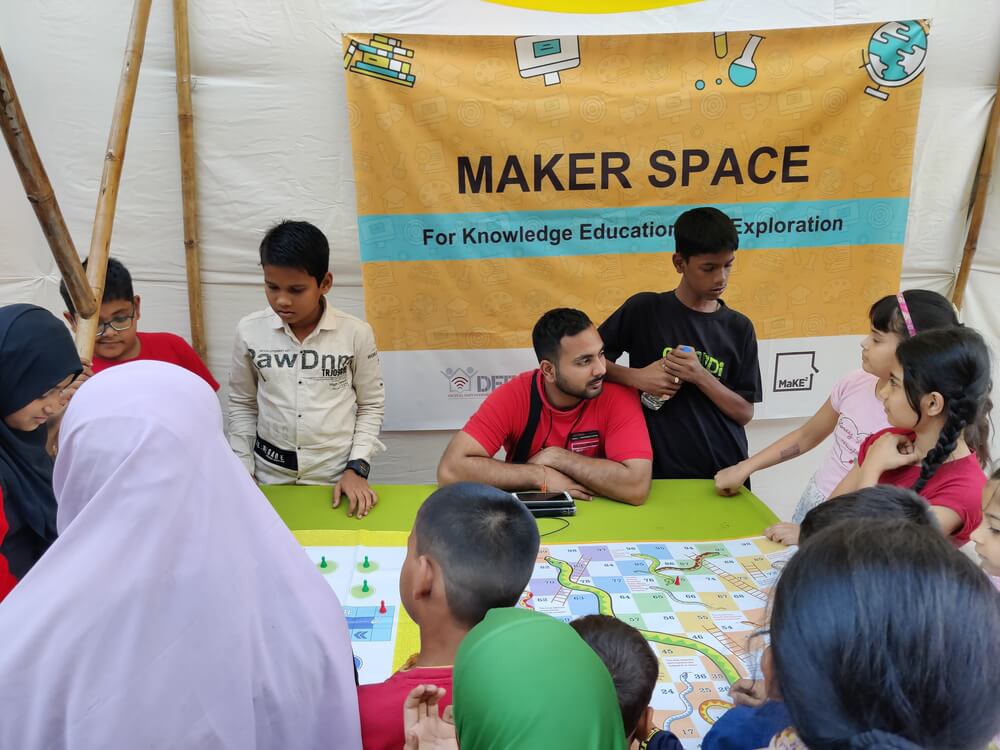
Photo: Jashvitha Dhagey
Priyansha Jain: Of course, we were focused on the Sassoon Docks Art project but, as the Mumbai Urban Art Festival, we popped up at many places like Mahim and Bandra. People are ready to engage with art, they have always been exposed to art, especially folk art. That is getting lost in some ways. People are not really accessing museums where they go and see something. They are ready to engage in a festival because they will have a say about what is being done. The Mumbai Urban Art Festival was a free festival, so everyone accessed it without limitation. We were expanding locations, whether at the docks or the Evelyn House where we did a plastic installation. I think the city is ready to engage with art. If we can take art to communities, we can hold festivals with less resistance.
Priyansha, how did the festival use mixed-media art to tell stories of people and also ecology? What was the impact?
Priyansha Jain: Since we were looking at water, issues related to Mumbai’ ecology came up during conversations with the artists. The location also lent itself to the nature of the work that was produced. We knew that the festival would have greater access since it was free. If the exhibits were highly conceptual, we would not have done justice to the audience. We have had a lot of youngsters visit. Though their way of interacting with art, driven by selfie culture, is clicking photos, it was good that they interacted.
People who attended the talks organised as part of the festival would come to the exhibition. Sometimes, it was not just what the artist intended to show, but also what people took away from it. Maybe 2.5 lakh people dropped in but the impact really goes beyond the numbers. A fisherman wanted us to extend the festival because the dock is cleaner as the Mumbai Port Trust was working more. That is the community impact which is not even directly related to the festival.
Do you see Govandi becoming a model that can be duplicated in other areas?
Natasha Sharma: Definitely. We want to hold the Govandi Arts Festival again in two years but in a different part of Govandi which will have its own challenges and re-modelling. This has great potential to spread in different marginalised neighbourhoods, for different marginalised voices, and not just across Mumbai but in cities across India. Bringing a revolution through creative expression one neighbourhood at a time.
Cover photo: Artwork by Paolo Defín at Sassoon Dock/ Maitreyee Rele

